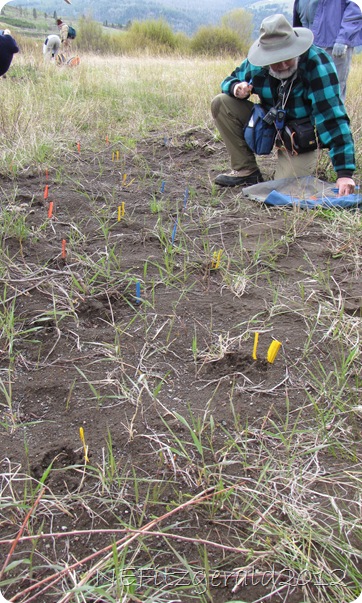In my last post I mentioned slogging through muddy, mucky river beds and boggy sage and/or willow flats. That’s pretty much how it’s done. If you ever want to track that charismatic central Rocky Mountain megafauna (or even the elusive Yellowstone two–lipped beaver), you might as well resign yourself to some serious slogging.
| Tracking in Soda Butte Creek |
During the first day of my recent four–day “Tracks & Mammal Signs” class with the Yellowstone Association Institute we spent a cloudy afternoon slogging along the rocky mud flats of Soda Butte Creek. We were below the confluence with Pebble Creek, looking for whatever had passed through on its way to wherever it was going.
Loaded with two spatulas, a bucket of plaster of Paris powder, and four plastic cups in which to mix it with water from the creek, we walked slowly, peering carefully here and there at the ground for signs of something. No one was really interested in elk, though. Too common. We wanted wolves! And grizzlies! Charismatic megafauna!
But wait…Is that a moose track? We’ll take it!
 |
| Hind moose track overprinting a front track in Soda Butte Creek |
Moose are not that common in Yellowstone (they are more so in the Tetons to the south, though), so our little team of two trackers was pretty excited. I never did actually see a moose during those four days. But by golly, I was tracking one so I was satisfied.
We mixed our plaster to the consistency of pancake batter and poured it into the track. It took 30 minutes to set and then voila! We had ourselves a moose track to take home.
 |
| Pouring the plaster |
Running is a bipedal function. During the four days we tried to think like a quadruped. Stride tells the size and speed of the animal. The grouping of prints tells the name of the gait. Our four–footed friends walk, trot, canter, lope, amble, and gallop but they do not run. Or so I was told in no uncertain terms.
 |
| Flagging prints to figure gait |
The second day out we found ourselves at the Wooden Bridge pullout on Soda Butte Creek, again loaded down with plaster of Paris, spatulas, and plastic cups. We were tracking the Lamar Canyon wolf pack in the mud and gravels along the creek bank. Woo Hoo!!!
However, engrossed as I was in tracking wolves, I was also looking around at other stuff. There were a lot of rocks in those stream gravels, and a lot of it happened to be petrified wood washed down from the cliffs towering above.
 |
| Stream gravels along Soda Butte Creek |
The nearby Absaroka Mountain Range was formed by volcanic eruptions that began around 50 million years ago when northwestern Wyoming was near the west coast of North America. Eons before Yellowstone existed, this volcanic activity produced massive ash and mud flows which buried and preserved standing redwoods and other trees covering the ancient hillsides.
 |
| Red arrows (mine, of course) point to white petrified trees |
At least twenty–seven different layers of ash and mud flows in Yellowstone have been recognized to have come from recurring volcanism that produced the Absaroka Range and buried the ancient tree-covered hillsides of northwestern Wyoming and a pre–caldera Yellowstone. These flows are thought to have occurred over about five million years, time enough for forests to regenerate themselves only to be buried over and over again by volcanic activity.
I gazed longingly at the petrified wood–studded cliffs but soon turned my attention back to the quadrupedal tracking task at hand.
The next day after slogging through more bison–infested sagebrush we wandered about on the mud flats of the Lamar River. Here I found bigger cobbles of petrified wood and there were also a few random tracks of a grizzly. Eureka! More charismatic megafauna tracks to take home!
In the end it was a productive four days, tracking animals in the wilds of northern Yellowstone and finding 50–million year old petrified wood fragments worn smooth by the rolling and tumbling action of those 50 million years. It was a load of information of which I can only wonder how much I will remember, but I walked away with a bucket full of useful tips to use on my ranger walks.
I finished my week with an overnight stay at Mammoth Hot Springs and discovered three new friends who were pleased to share my adventure.
 |
| Female great horned owl rests atop a chimney |
 |
| Two fluffy owlets wait for a snack in a nearby tree |






